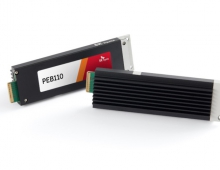
Elpida, Qimonda Team on DRAM, Consider Joint Production, Merger
The industry's third largest manufacture Qimonda AG of Germany and the fourth largest Elpida Memory Inc have exchanged a memorandum of understanding (MOU) regarding their joint DRAM development.
The companies will sign an official agreement in the near future. The MOU covers free cross-licensing of both companies' all intellectual properties including design and process technologies, in addition to their joint development of 40nm and later generation DRAM products.
The MOU was formulated "with the view to establishing a joint plant, manufacturing each other's products and even merging management of the two companies," said Shuichi Otsuka, director and COO of Elpida.
The joint development in the MOU targets 40 to 30nm-generation DRAM products with 4F2 (F: feature size) cell size. The development will combine Elpida's advanced stack capacitor technology and Qimonda's "buried wordline technology" announced in February 2008.
Specifically, the companies are intending to miniaturize the cell and lower wiring resistance at the same time by applying Qimonda's expertise in metal gates (and metal wordlines) included in the buried wordline technology. As the companies will standardize their process technologies and design rules in the joint development, they will be able to manufacture DRAM products based on the same device structure in and after the 40nm generation.
Both companies will focus their 40nm and later development on this joint development.
The partnership will extend further than the joint development of DRAM technology. Although excluded from the MOU, the companies are discussing two other policies to reinforce their partnership.
One is the joint development of PRAM (phase change RAM), MRAM (magnetoresistive RAM) and other next-generation memory technologies and Si through-hole electrode technology. And the other is the co-production using a joint plant and the production of each other's products.
If they establish a joint plant, "We can also co-produce DRAM products before the 40nm generation as well," said Takao Adachi, director and CTO of Elpida. In addition to these two policies, "We will also explore the possibility of our management merger" as the ultimate form of partnership, Elpida's Otsuka said.
Elpida seems to have considered Qimonda a prime candidate of its partner, but the trench technology that Qimonda had employed appears to have been the obstacle when considering standardizing their process technologies. As Qimonda announced the stack type buried wordline technology in February, "We no longer had the obstacle in our way," Elpida's Adachi said. The companies began to negotiate their partnership "from March" immediately after that, according to Adachi.
The MOU was formulated "with the view to establishing a joint plant, manufacturing each other's products and even merging management of the two companies," said Shuichi Otsuka, director and COO of Elpida.
The joint development in the MOU targets 40 to 30nm-generation DRAM products with 4F2 (F: feature size) cell size. The development will combine Elpida's advanced stack capacitor technology and Qimonda's "buried wordline technology" announced in February 2008.
Specifically, the companies are intending to miniaturize the cell and lower wiring resistance at the same time by applying Qimonda's expertise in metal gates (and metal wordlines) included in the buried wordline technology. As the companies will standardize their process technologies and design rules in the joint development, they will be able to manufacture DRAM products based on the same device structure in and after the 40nm generation.
Both companies will focus their 40nm and later development on this joint development.
The partnership will extend further than the joint development of DRAM technology. Although excluded from the MOU, the companies are discussing two other policies to reinforce their partnership.
One is the joint development of PRAM (phase change RAM), MRAM (magnetoresistive RAM) and other next-generation memory technologies and Si through-hole electrode technology. And the other is the co-production using a joint plant and the production of each other's products.
If they establish a joint plant, "We can also co-produce DRAM products before the 40nm generation as well," said Takao Adachi, director and CTO of Elpida. In addition to these two policies, "We will also explore the possibility of our management merger" as the ultimate form of partnership, Elpida's Otsuka said.
Elpida seems to have considered Qimonda a prime candidate of its partner, but the trench technology that Qimonda had employed appears to have been the obstacle when considering standardizing their process technologies. As Qimonda announced the stack type buried wordline technology in February, "We no longer had the obstacle in our way," Elpida's Adachi said. The companies began to negotiate their partnership "from March" immediately after that, according to Adachi.





















